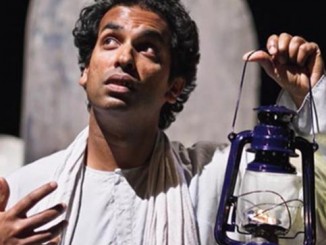
[“The Secret to Life is Inconsistency”]
From the moment the striking white lights brighten the black box of Q Theatre, Jacob Rajan captures the full attention of every audience member as Harvey Norman worker, Kutisar. He lies sprawled on a plinth, perhaps dead, or at least close to death. In swoops a Vulture, expertly animated by puppeteer Jon Coddington. The construction of the Vulture allows the materials to rattle as the wings spread, accompanied by curious yet sinister squawks and hisses.
Rajan quickly establishes the rules of the world, where exiting the space on the stage unleashes a torrent of extreme noise, lights, and pain. It is clear Kutisar is trapped in a limbo, maybe even a purgatory, unable to distinguish whether he is alive or dead. Rajan’s skill in physicality is clear as he utilises the soft-soled shoes to his advantage, slipping around the stage, before transporting to Kutisar’s younger self at a Mumbai disco. Here Kutisar meets self-assured and foul-mouthed Meera (also played by Rajan), a young Parsi woman with whom the rest of Kutisar’s story intertwines with. Playful jabs are taken at the ‘wealthy’ Parsi community in Mumbai, with enough information given for the Kiwi audience to appreciate. As someone of Indian descent who has some knowledge of different religious and ethnic groups within India, I appreciated co-writers Rajan and Justin Lewis’ ability to represent these groups in a humorous, accessible way, without losing the integrity of the history and people.
As Meera guides Kutisar up to the Malabar Hill into the Temple of Silence, where Parsi take their dead to receive a sky burial to have their corpses consumed by vultures, Rajan’s physical and vocal versatility seamlessly switches between characters. It is not an exaggeration to say I often forgot I was watching one man on a nearly empty stage, instead of a pair in the bustling city of Mumbai.
The interplay between characters is a consistent highlight throughout the performance; Rajan also embodies a myriad of characters including Meera’s Aunty, a loan shark and a professor at the Natural History Museum. The transition from young Kutisar to his older self deserves special mention – we could see the aging process happen before our eyes and could feel the effects of 30 years on a body despite it not being our own. These moments are contrasted with the rapid dialogue between four characters later in the show, delivered with such deliberate and concise switches it is not only easy to follow, but extremely enjoyable to immerse yourself in.
The integrated Indian vocabulary, such as kulfi (ice-cream parlour) and chaiwallah (street tea seller) throughout the script is comprehensible to all, perfect for an audience who presumably are accustomed to the integration of Te Reo Māori vocabulary in their daily lives already.
The variety of choices made for scene and location transitions were a testament to the experience and knowledge of director Justin Lewis and the company. Rajan executes quick spins when introducing new characters to the scene, allowing the tension to be carried through the passing time, while nightclub dance breaks reset the light-hearted energy, drawing many laughs. AV and lighting adds context of time and place to these transitions, accentuated by the specific details of the sound design, turning the stage of the Q Theatre into a kulfi ice-cream shop and a museum laboratory with ease. A bell chimes motif is used consistently and fluently in times of transition when characters are reaching a realisation or decision. Each transition perfectly fits the situation, directing the mood of the audience from muffled laughter to shock and back to full belly laughs.
The inability for Meera and the Parsi people to have the death rituals they desire is not an uncommon situation for many in India to find themselves in. The Covid-19 outbreak recently affecting India has disrupted the practices of mourning and death for people in many communities, religions, and ethnic-groups alike. Even in New Zealand, tangihanga and funeral were among the most discussed gatherings disrupted during lockdown periods. By activating our prior experiences, Indian Ink bring empathy and support for their characters and situations in the production, and for those facing the effects of vulture depopulation and other barriers to ritual, that otherwise may have been overlooked due to cultural differences.
At interval, audience members were offered samples from Meera’s kulfi shop – such a thoughtful act that really cemented Indian Ink as a brilliant company in my eyes. This is a show that brings such laughter and energy into the space, while delivering content on true issues from India that you will find yourself desperate to research more into, and hopefully more empathetic to the current issues surrounding mourning rituals India is facing.
Paradise or the Impermanence of Ice Cream plays Q Theatre 9-26 June, 2021.
SEE ALSO: Jess Macdonald’s review of the 2020 development season.




Leave a Reply